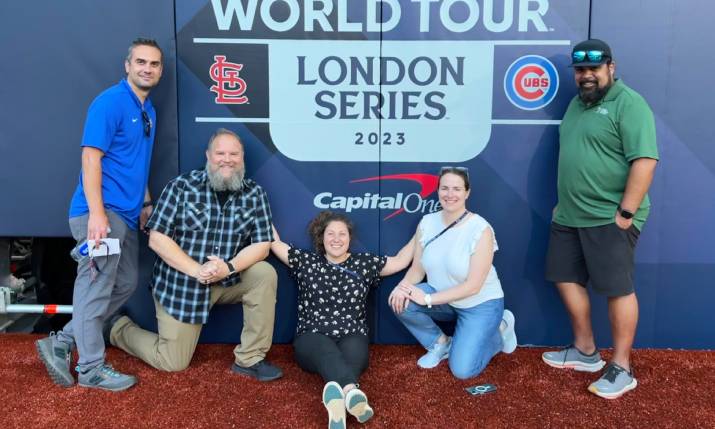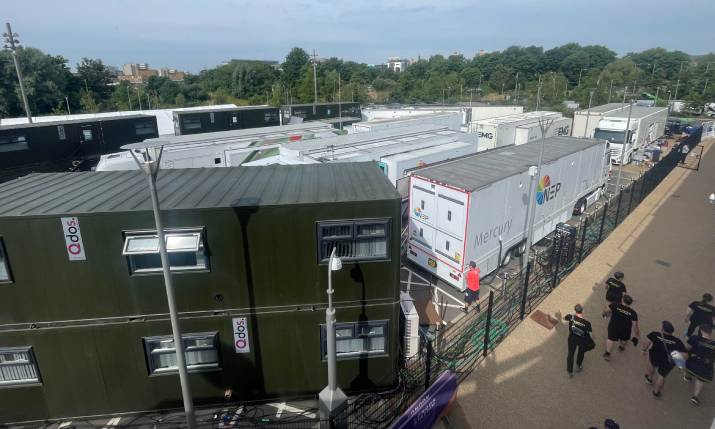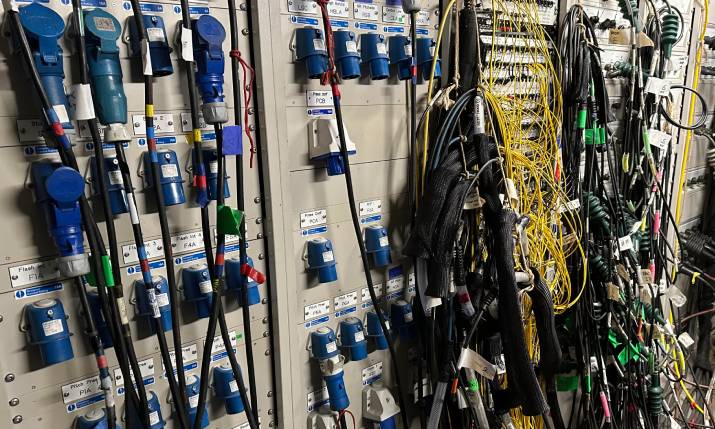Raising everyone’s game: How MLB polished the diamond at the London Series Baseball

The core team for MLB in the TV compound with [left to right] Jason Lamanna, technical manager, Jason Hedgcock, senior director remote tech ops, Samantha Calastro, senior production manager, Stephanie Perone, director remote tech ops, and Tony Johnson, lead RF technician for MLB Network
In June MLB was in London for the first time since 2019, and the diamond was shinier than ever. MLB has been upping its baseball coverage year on year, and its audio approach to the double header between the Chicago Cubs and St. Louis Cardinals at London Stadium was unlike anything they had done outside of the US before.
The 2023 MLB London Series gave international rightsholders more of everything; more audio channels, more creative opportunities and more control. And while MLB’s approach inevitably took more planning and took more time to set up, it provided every rights holder with the opportunity to create their own unique presentation.
More, more, more
MLB is broadcast to over 40 territories and fans are engaging not only across live channels but on demand, with a variety of output audio formats to cater for different environments.
Jason Hedgcock, senior director, remote technical operations at MLB Network, is all about providing the ability to create the formats which meet the needs of those environments. Fulfilling a dual role in London, Hedgcock ensured that MLB was not only providing better support for its international customers, but also continuing its commitment to providing onsite coverage for the BBC.
“With European football there are often just a few centralised game cameras which can cover an entire game and not miss a moment of the action,” says Hedgcock.
“Baseball isn’t like that. It’s a sport that demands a good cut of cameras and there is a lot of planning and development with the host broadcasters: what are you going to shoot, how you are going to mic everything, what your effects feeds are going to sound like.
“Baseball also has a more detailed soundscape. It’s much more than just crowd noise. It has a range of different sounds, like the pop of a glove, the crack of the bat and talk between players on the field. To grow this game we owe it to all our rightsholders and customers everywhere to be able to hear those things, because all these sounds really enhance the game experience.”
With broadcasters finding new and creative ways to put their personal stamp on a world feed, MLB has been working with its international partners to enable them to put their personal flare on how games are presented without having to come to site to do it.

The TV compound at the London Stadium for MLB’s first visit to the city since 2019
Tic TOC
Hedgcock’s approach was new to MLB’s international showcase games. Signal flow was complex with multiple ways for rightsholders to access broadcaster content. In addition to the traditional world feed clean FX, individual audio channels were fed into an onsite Technical Operations Centre (TOC), supplied by NEP, where onsite OB units took feeds for the BBC and BT Sport, as well as host broadcasters Fox (for Saturday’s game) and ESPN (for Sunday’s game).
The TOC also converted the frame rates which allowed all rightsholders to deliver content in different formats, and ISO feeds were sent directly from the TOC to MLB’s New Jersey hub for the creation of behind-the-scenes content for MLB’s fan-favourite ‘Play Loud’ YouTube channel.
Despite the complexity, the foundations were refreshingly simple.
Hedgcock explains: “Whenever you have multiple trucks in a compound you have to drive the network off of the lowest technology truck. In this case the most palatable technology was MADI, so we built a MADI network and shared the master MADI information and stream with all the other audio teams. This meant they could pick off what they needed to build their own mix.
“We had a portable office unit packed with standards conversion equipment and audio distribution for the MADI Streams, which acted as a central distribution point for OBs to access transmission signals and to distribute the entire MADI network.
A rising tide lifts all ships
“It allowed us to give each of our rightsholders the ability to control their own destiny. If you’ve got a host broadcaster like ESPN or Fox laying out 60 different microphones to capture the sounds of the game, someone like the BBC or BT Sport can benefit from that too because we’re making those feeds available to everybody. It’s not just about what you’ve got on the truck and what your network can afford; you’re getting access to those resources from the top down.”
With a traditional clean FX feed embedded on its distribution path for any rightsholders that need it, MLB ensured that all bases are covered, but not everything was shared. In fact, the host broadcaster was given sole access to even more, highly personalised content.
The personality and drama of baseball is as big of a draw as the action, and MLB have developed engagement strategies to give its viewers even more access to the players. In addition to distributing audio feeds and providing standards conversion, the TOC also sent isolated multitrack feeds of players to MLB HQ in New Jersey for its Play Loud YouTube property. Play Loud takes isolated camera footage with associated audio from RF microphones which are associated with specific players and cuts it into a specialty package for distribution.

MLB’s I/O room for the stadium
Chitter chatter
Player mics are located in the piping around the collar on the uniform and a rubberised transmitter sits between the player’s shoulder blades in a custom pocket, allowing them to be miked up with no negative impact on their physicality. In London MLB miked players from both teams, where the audio was embedded onto isolated cameras and it sent back to an editing team in New Jersey.
In addition, the host broadcasters had exclusive access to players during the game, and were able to talk with them while play was ongoing.
“We also mic up the umpires, and players often have interruptible foldbacks (IFBs) to allow them to interact with the host broadcaster commentary booth as part of the live presentation,” adds Hedgecock. “On their designated inning our A2 sets each player up with an IFB as they go out on the field of play to enable them to have a conversation with the announce booth, and at the conclusion of that inning they take the IFB off.
“There are some limitations from both the players Union and MLB in terms of who can access some of this more intimate content, and we haven’t yet tackled how to integrate that with our international, non-English language audiences; that’s where Play Loud comes into its own, as we capture what’s naturally happening in the player’s native language.”
What’s on the menu?
The level of access to both the action on the field and the audio feeds from the game is always developing, and the level of coverage of this year’s London Series game and four years ago is incomparable.
But Hedgcock sees all this as a positive, upping the game for everyone. “We’ve optimised some of the things that came out of the pandemic, but when you think about distribution platforms it is impossible to keep up; there are just too many variables around how people are getting their content. Is someone watching on a phone or a tablet or in a bar or at home or in a hotel? The sustainable model is about finding a base level.
“I think the inevitable place we end up is similar to a restaurant menu where we sit down in the compound ahead of time and decide which audio stems we can make available, which video stems are available, and what we can provide to everyone. Giving broadcasters the ability to choose what they need for their broadcast from a predetermined list and taking any additional requests as they come.
“If we can provide the clean effects from the game, clean crowd atmosphere, clean announcer feeds; these are the clean building blocks which anyone can build a show from. Use what you need, build what you need.
“Handing off really good building blocks for people to create their own lenses is the sustainable model for the future.”

